How To Make Sauerkraut
This post may contain affiliate links. See my disclosure policy.
A comprehensive, step-by-step pictured tutorial on How to Make Sauerkraut that is incredibly healthy and delicious! Making your own fermented homemade sauerkraut is super easy, requires minimal prep work, and the rest is just a waiting game. This Sauerkraut recipe covers everything you need to know to ensure your success!
For another probiotic-packed food, be sure to check out my tutorial for How to Make Yogurt!
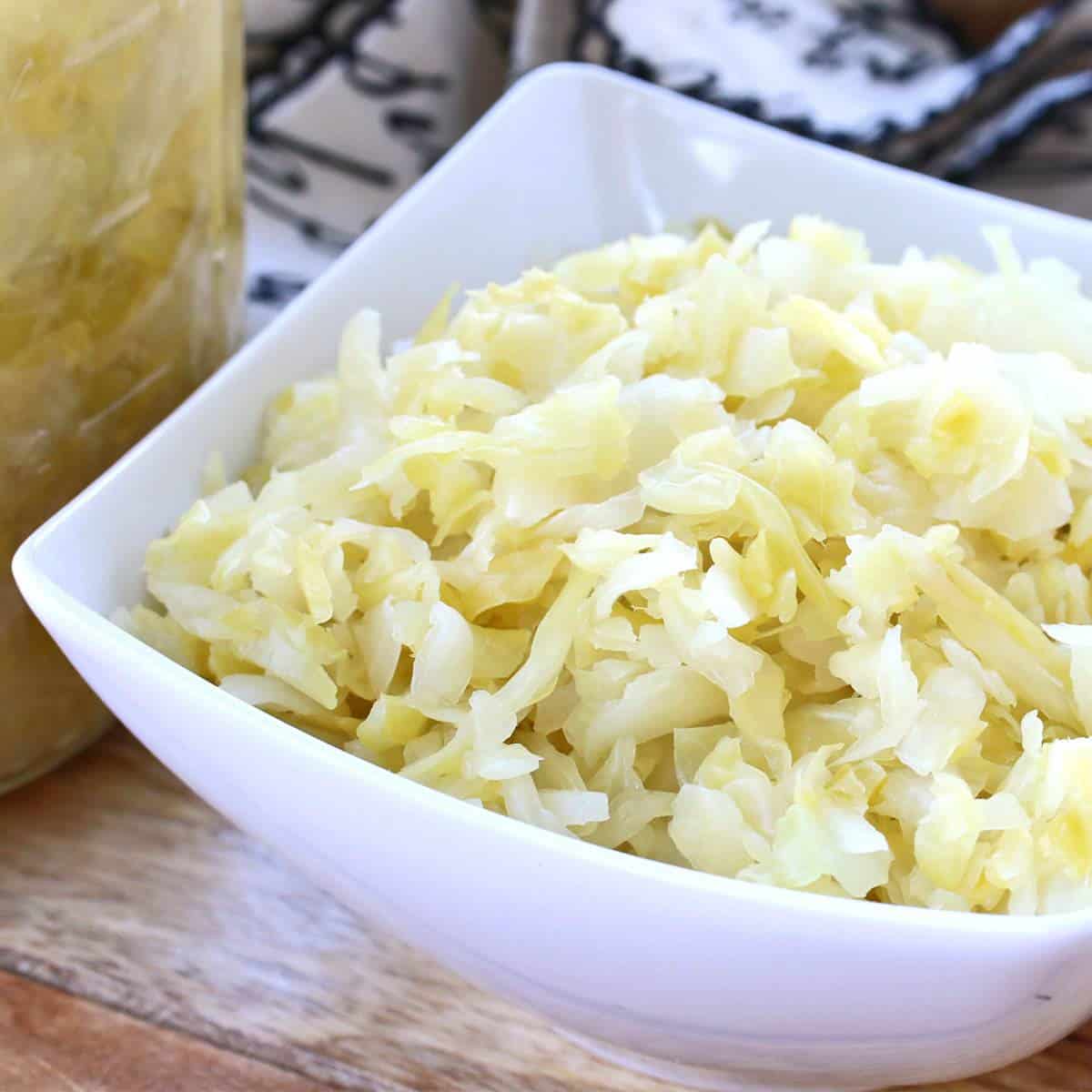
Sauerkraut is in my blood. Being from Germany and raised by a health-conscious mom, I ate this stuff on a regular basis. In Germany sauerkraut is eaten fresh or cooked in a wide variety of dishes; everything from casseroles and soups to salads or alongside meats and sausages. Raw fermented sauerkraut was always readily available in our local health food stores. My mom and I regularly went to our local Reformhaus and in the refrigerated section was a large vat of fresh sauerkraut where we could scoop out as little or as much as we wanted into the bags provided. We’d often nibble on some of it as we made our way through the outdoor shopping district and then take the rest home with us. This ancient skill has been making a comeback in recent years both overseas and in the U.S., with a growing number of people learning how to ferment their own foods.
I’ve been fermenting vegetables, grains, legumes, and dairy products for over a decade and it is a deeply satisfying venture. If you’ve been curious about how to make sauerkraut it’s time to make that leap. For anyone interested in trying their hand at fermentation, sauerkraut is the perfect place to start!
Why You Should Make Your Own Sauerkraut
The benefits of probiotics are well-established and the fact that you’re here reading this means you’re already aware of that. And you’re probably also aware that there is no better or easier way to access a wide spectrum of probiotics than making your own sauerkraut. With probiotic supplements you’re limited to a couple or few select strains. Research has shown homemade fermented sauerkraut to contain as many as 28 separate and distinct strains. No probiotic pill can replicate that. Not to mention that there is no way to verify how much of the bacteria is even still alive in probiotic supplements.
With homemade fermented sauerkraut you’re benefitting not only from a large variety of probiotic strains, you’re also getting a large dose of live, healthy, and robust ones.
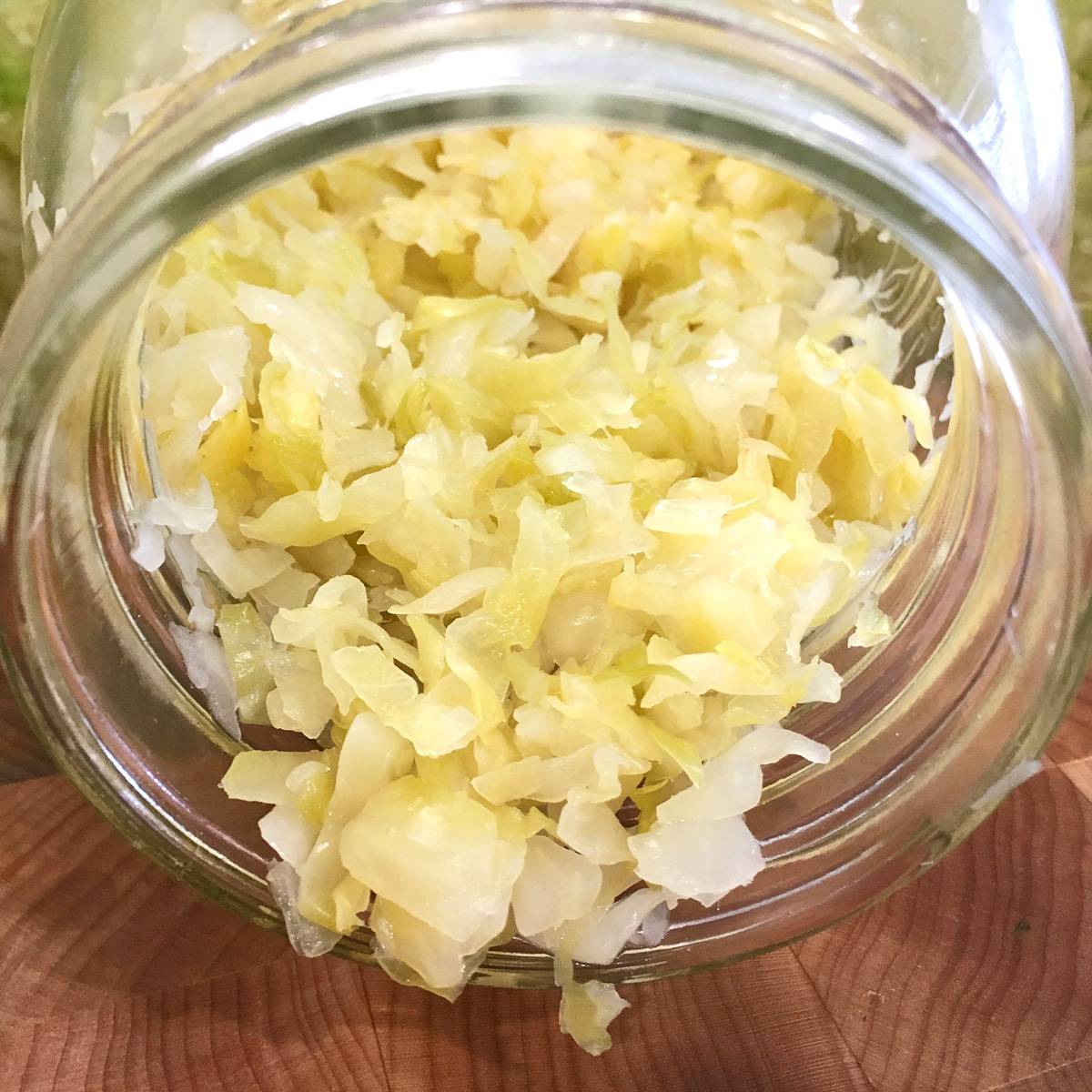
Equipment For Making Sauerkraut
You don’t need any specialized equipment to make sauerkraut.
- A large glass or ceramic jar (I regularly use half gallon Mason jars)
- Some kind of heavy, flat-bottomed tamper for crushing the cabbage
- Something flat to weigh down the cabbage that’s relatively close in size to the diameter of the jar you’re using
- Fresh cabbage
- Salt (sea salt or kosher salt)
That’s it. You don’t need any specialized tools, gadgets, or equipment. People have been successfully making sauerkraut for many centuries using the most basic supplies and chances are you already have what you need on hand and can easily improvise if you need to.
Specialized Equipment (Optional)
Alternatively you can invest in some dedicated equipment, some of which (airlock lids) will make the process more maintenance-free:
- Airlock lids – These lids prevent mold spores/yeasts from getting into the jar so that you don’t have to monitor it as closely or remove mold as it forms. They also automatically release air pressure as the veggies ferment so you don’t have to manually open the jar on a daily basis to release the pressure.
- Sauerkraut Crocks – These come in all difference sizes depending how large of batches you’re making. Some crocks come in a kit with a tamper and weight.
- Sauerkraut Tamper/Pounder – You can find these in wood or stainless steel and they allow you to pound the cabbage to release its liquid and then use it as a tamper for stuffing the cabbing in the jars.
Additional Resources
- The Art of Fermentation by Sandor Ellix Katz – The ultimate guide to fermenting anything and everything, including sauerkraut. It’s my favorite book on the subject and the one I most highly recommend.
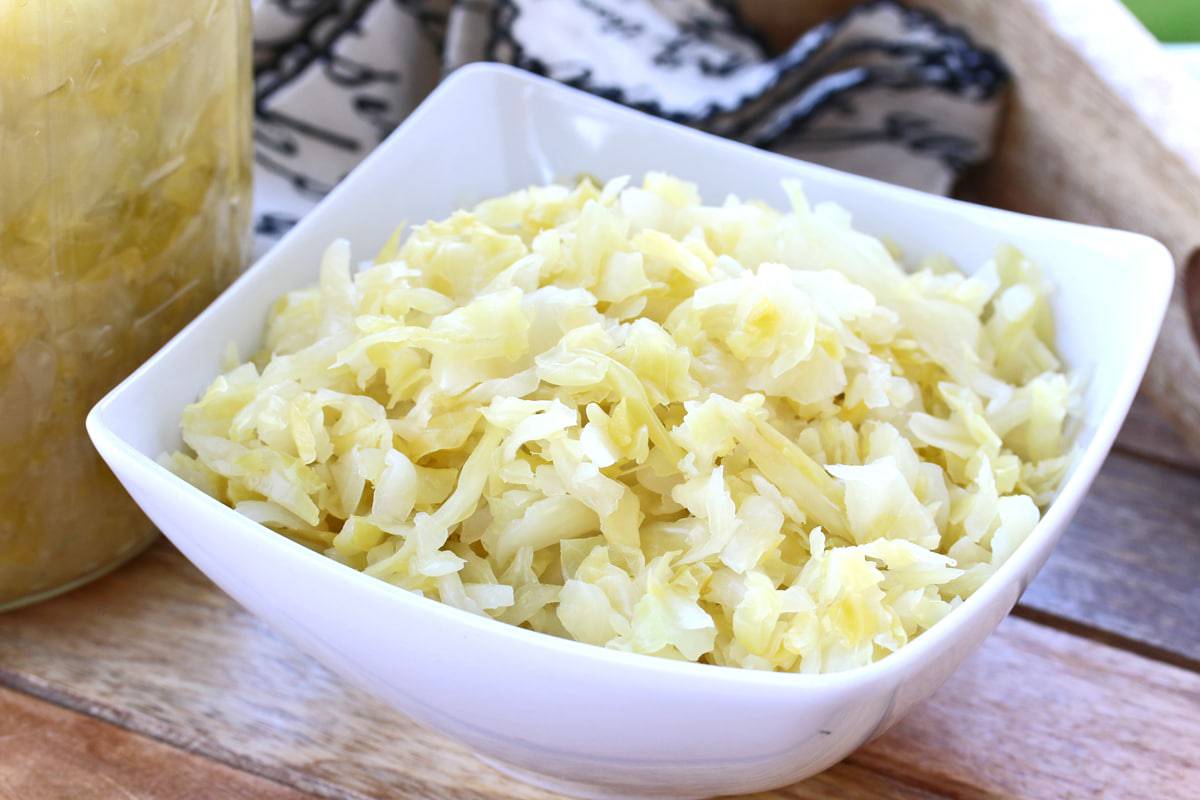
How Long Does Sauerkraut Keep?
Stored in a dark, cool place it will keep for many months. The cooler the storage area the longer it will keep. I keep mine stored in the fridge. Even in a cold environment like the fridge, sauerkraut will continue to ferment though at a much slower pace.
Can You Freeze Sauerkraut?
Yes, but just know that it will kill the probiotics. Cooking the sauerkraut will also kill the probiotics. So if your objective is to reap the benefits of the probiotics, eat it raw and unfrozen. If your objective is simply to enjoy it cooked as a delicious food (and delicious it is!), you will still reap the benefits of its vitamins and fiber.
How Long Does it Take to Ferment?
As long as you want it to until it reaches the desired texture and level of tanginess. Days. Weeks. Months. It will become tangier the longer it sits.
The length of the fermentation time will depend primarily on the temperature of the environment. The cooler the environment, the longer it will take to ferment. The warmer the environment the quicker it will ferment, the flavor will be inferior, and the sauerkraut is at greater risk of developing unwanted yeast and going bad. The ideal temperature for sauerkraut is 65-70 F. At that temperature we recommend letting it ferment for at least 2 weeks (preferably longer) but you can cut it shorter depending on your taste preference.
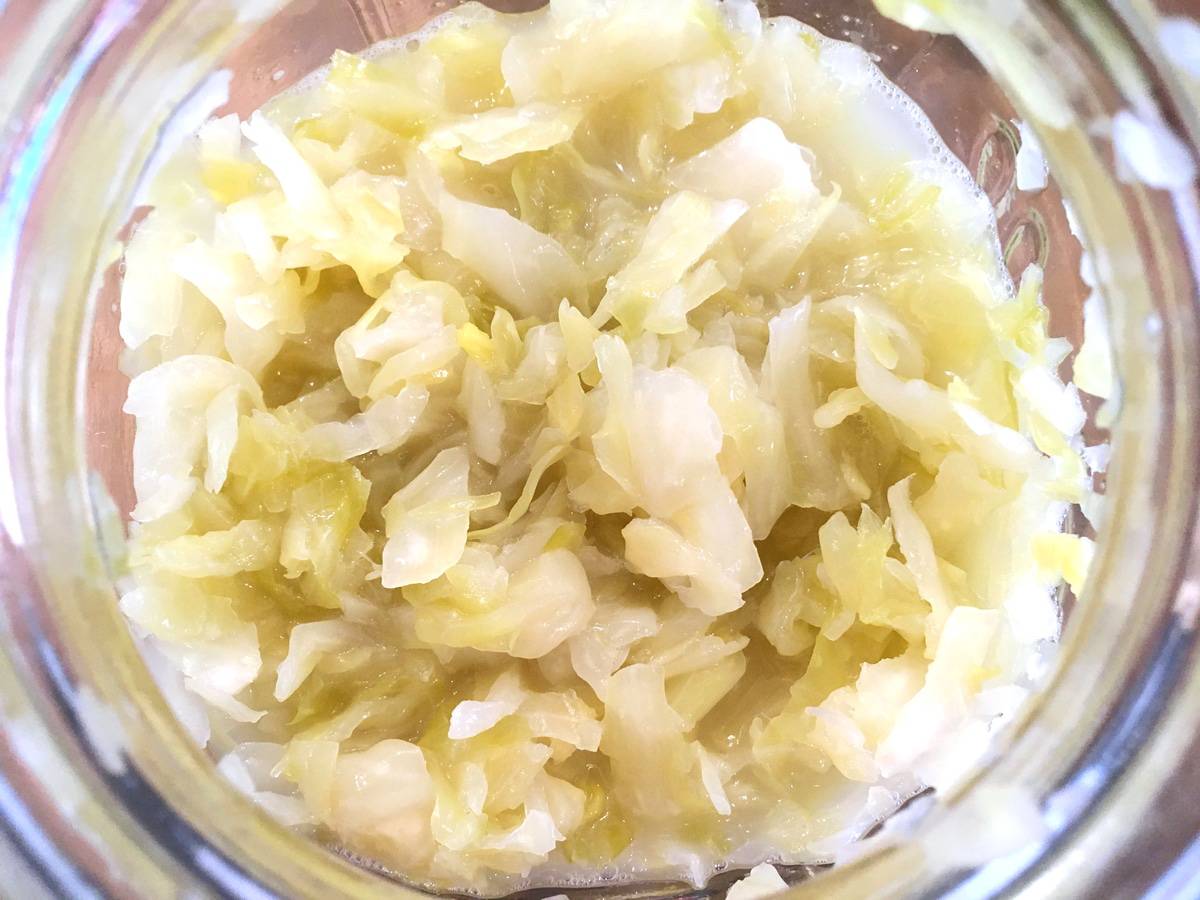
Can I Make Sauerkraut Without Salt?
While you can make sauerkraut without salt and you can find information on alternatives online, we do not recommend it. Salt is a key ingredient in fermenting foods for several reasons: 1) It creates an environment that favors the formation of lactobacillus bacteria (good bacteria) and prevents unwanted bacteria and yeast from forming, 2) It prolongs the shelf-life, 3) It helps preserve the vitamin and mineral content of the food, 4) It improves the flavor, 5) It helps keep the vegetables crisp and crunchy, and 6) It slows down the fermentation process so that the vegetables can develop a fuller, more complex flavor.
Fermented vegetables, including cabbage, do best with a salt content of 2-3%. Translated in measurements that’s 1 1/2 to 2 teaspoons of salt per pound of cabbage (9-12 grams of salt per 450 grams of cabbage).
Does Sauerkraut Go Bad?
While fermented foods are slower to go bad, they most certainly can and will in time. So how can you tell if sauerkraut is bad? See below.
There’s Mold On It: Is it Safe to Eat?
In most cases it is perfectly safe. Mold most often occurs when the cabbage isn’t submerged under the brine and comes in contact with air. When this happens it is perfectly safe to remove and discard the top layer of the sauerkraut. This is true if the mold is a greenish or grayish color. If however the mold is black, orange, or pink or if your sauerkraut has changed to an unpleasant color, slimy texture, or bad smell, then toss it.
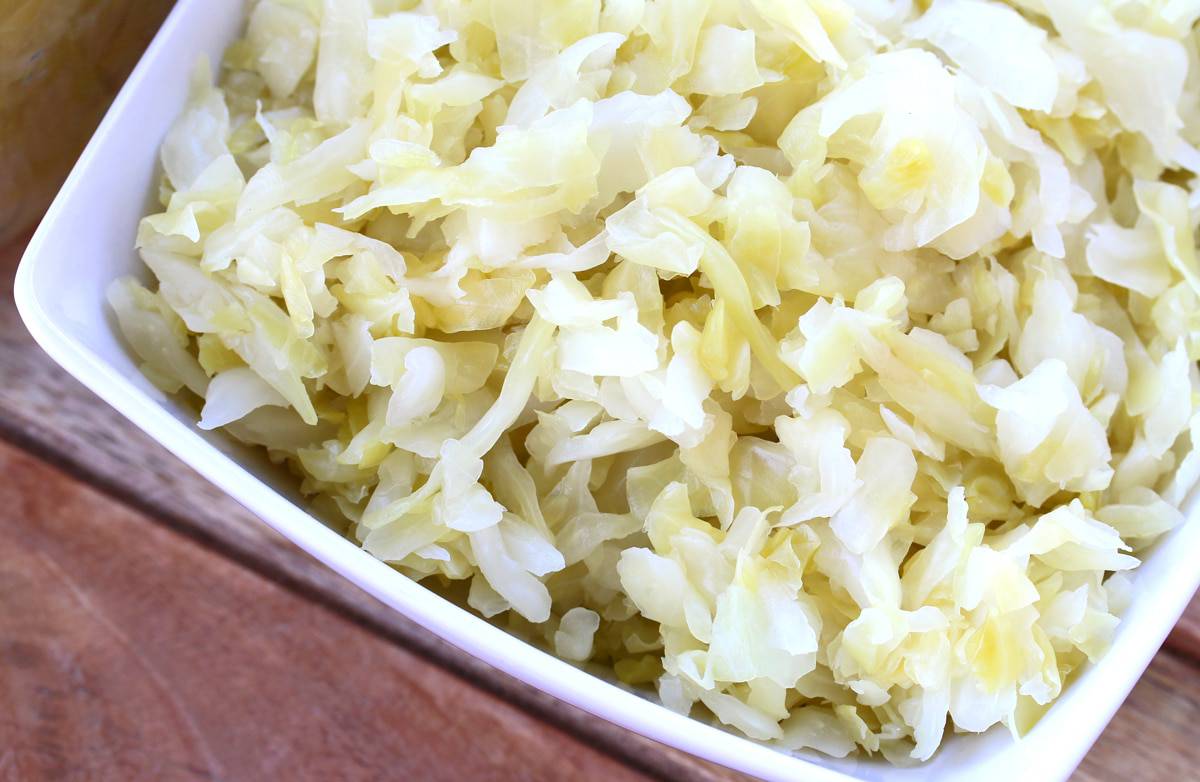
How to Make Sauerkraut
There are number of ways you can approach making sauerkraut but the overall method and principles are the same: Chop, salt, and keep the cabbage immersed under liquid until it’s fermented. There are also a number of flavor variations you can experiment with. For example, in Germany it is not uncommon to include whole, crushed juniper berries or caraway seeds.
I’m presenting a basic sauerkraut recipe but feel free to explore and experiment with flavors. Here a summary of the basic steps and below I’ll take you through those steps in detail:
- Chop the cabbage and place it in a large flat-bottomed bowl.
- Salt the cabbage.
- Pound the cabbage to release its juices.
- Transfer the cabbage to a glass or ceramic jar or crock and use a tamper to push the cabbage down into the jar to remove any air pockets until the cabbage is completely submerged under the brine.
- Place the lid on the jar, put the jar in a cool, dark place, and wait. Remove the lid every day to release air pressure, to make sure the sauerkraut is submerged under the brine.
- Taste the sauerkraut every day after the first few days until it reaches the desired texture and level of tanginess.
- Screw the lid on tight and store your finished sauerkraut in the fridge or a cool cellar.
Prepare the Cabbage:
Remove any bruised or damaged exterior leaves from the cabbage, then cut the cabbage in half and remove the core. Slice the cabbage very thinly, approximately 1/8 inch thick. For the best texture we recommend slicing it very thinly by hand, not with a food processor. You can slice it by hand, use a mandolin, or cabbage slicer.
Place the sliced cabbage in a large bowl and toss in the salt. Let it sit for about 20 minutes until the cabbage has begun to wilt and releases some of its juices. Use a tamper/pounder to crush the cabbage until it is wilted and has released a lot of liquid. This will take several minutes.
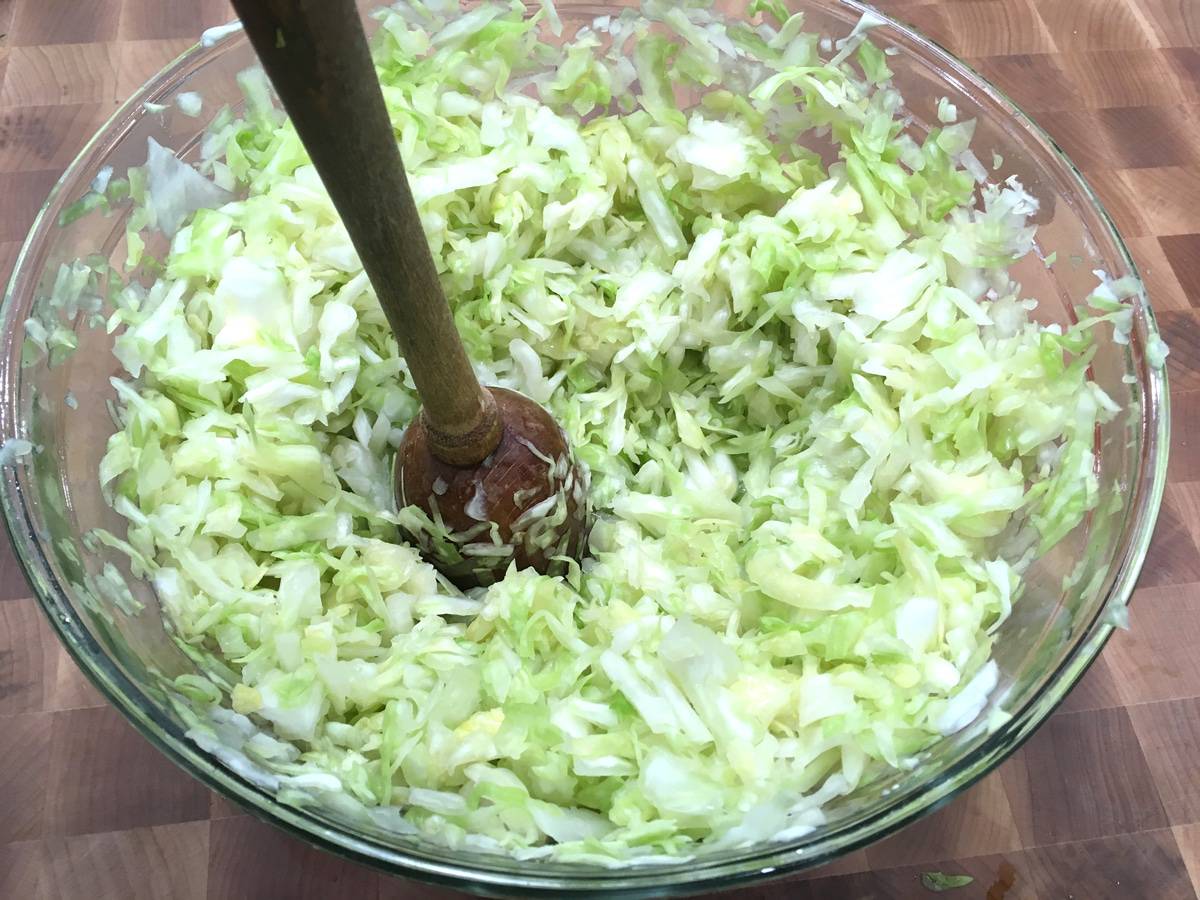
Pack the Cabbage into a Jar or Crock:
Transfer the cabbage and all the juices to a glass or ceramic jar or crock a bit at a time and mash it down with a tamper. Fill the jar to about 2/3 full (the cabbage will bubble as it ferments and could overflow if the jar is too full).
Continue to mash the cabbage with the tamper, releasing more juice, until the cabbage is completely submerged under the brine.
If you’ve mashed all you can mash and you still don’t have enough brine to cover the cabbage you’ll need to make some supplemental liquid that is consistent with the salinity of the cabbage brine: Dissolve 1 teaspoon of salt in 1 cup of water (a 2% salt water solution) and add that to the jar until the cabbage is completely submerged under the liquid.
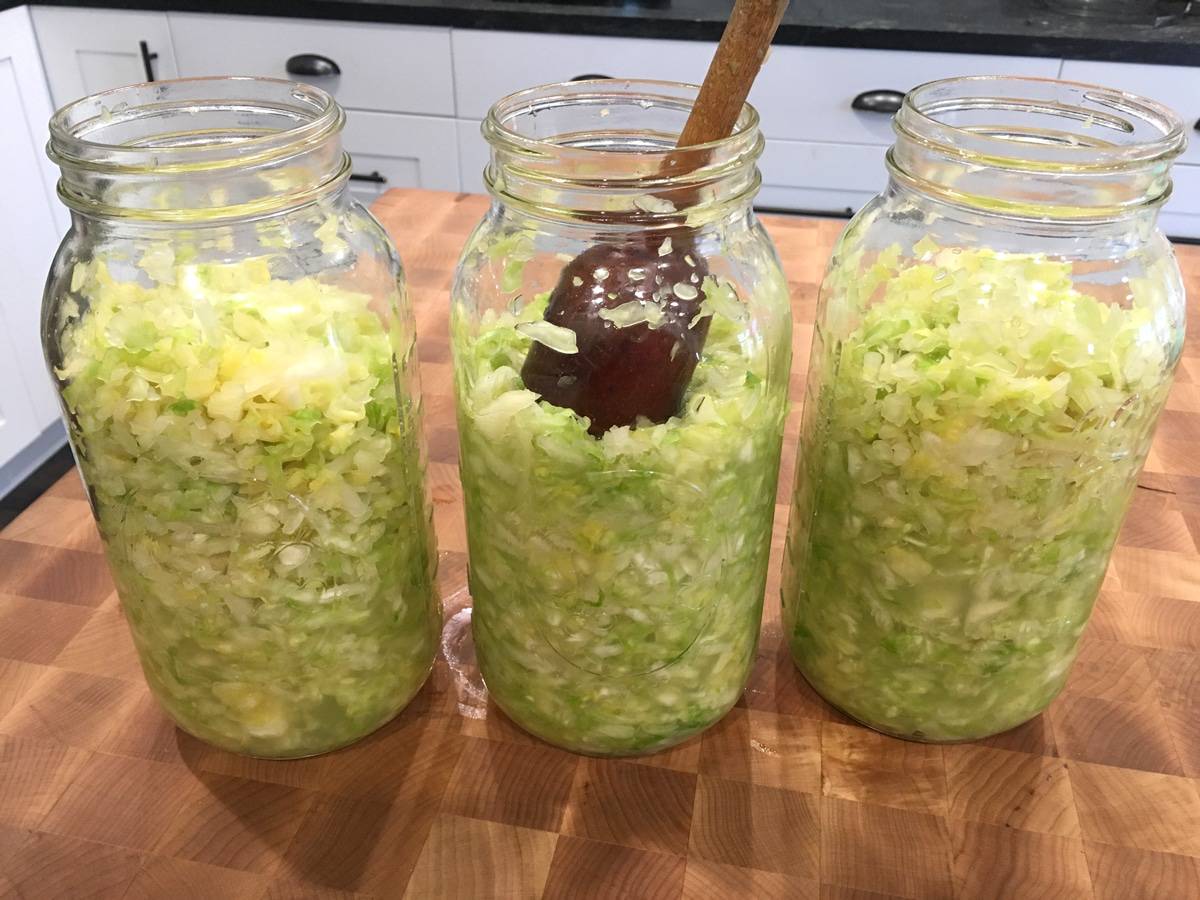
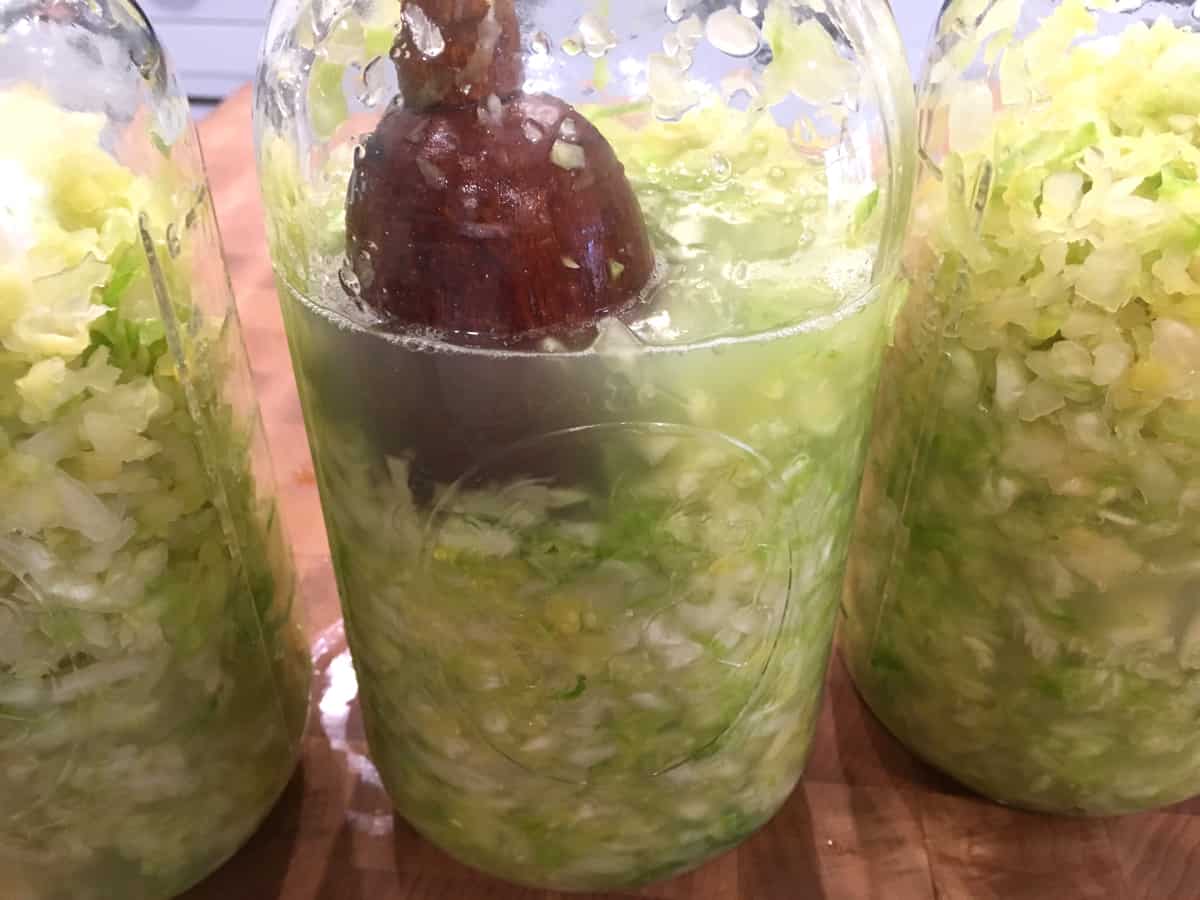
It’s also important to mash the cabbage to remove any air pockets in order to prevent mold growth.
The prep work is done.
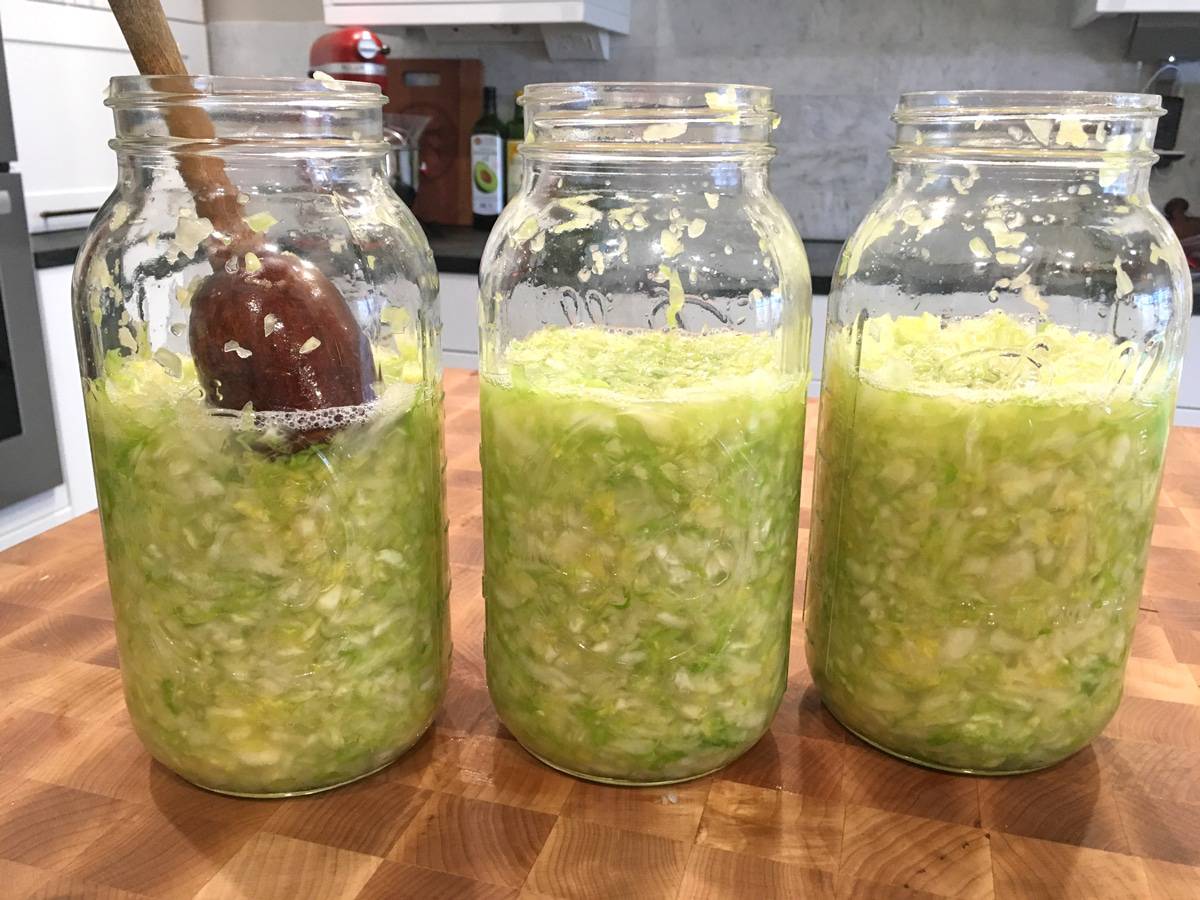
It is imperative that the cabbage remain submerged under the brine during fermentation, otherwise mold will form (See section above “My Sauerkraut Has Mold on it: Is it Safe to Eat?”). To do this choose a heavy object whose diameter is roughly the same size to the inside of the crock you’re using. The object should be glass, ceramic, or non-reactive metal.
Note: I have made sauerkraut multiples times in large mason jars (usually 1/2 gallon size) without needing to use weights. Because of the small diameter of the jar, after a day or two of fermenting the cabbage usually remains below the liquid level. If the cabbage rises above it I just mash it back down with the tamper. If you choose to use mason jars without using something to weigh down the cabbage, just be sure to keep a close eye on it each day throughout the fermentation process.

Let the Fermentation Begin!
Screw on the lids to fingertip tightness. If using airlock lids, follow the instructions provided with your lids.
Place the jars in a dark place that is between 65-70 degrees F, the ideal temperature for fermenting. (See section above “How Long Does it Take to Ferment Sauerkraut” for information on temperature variations.)
Now it’s time to WAIT.
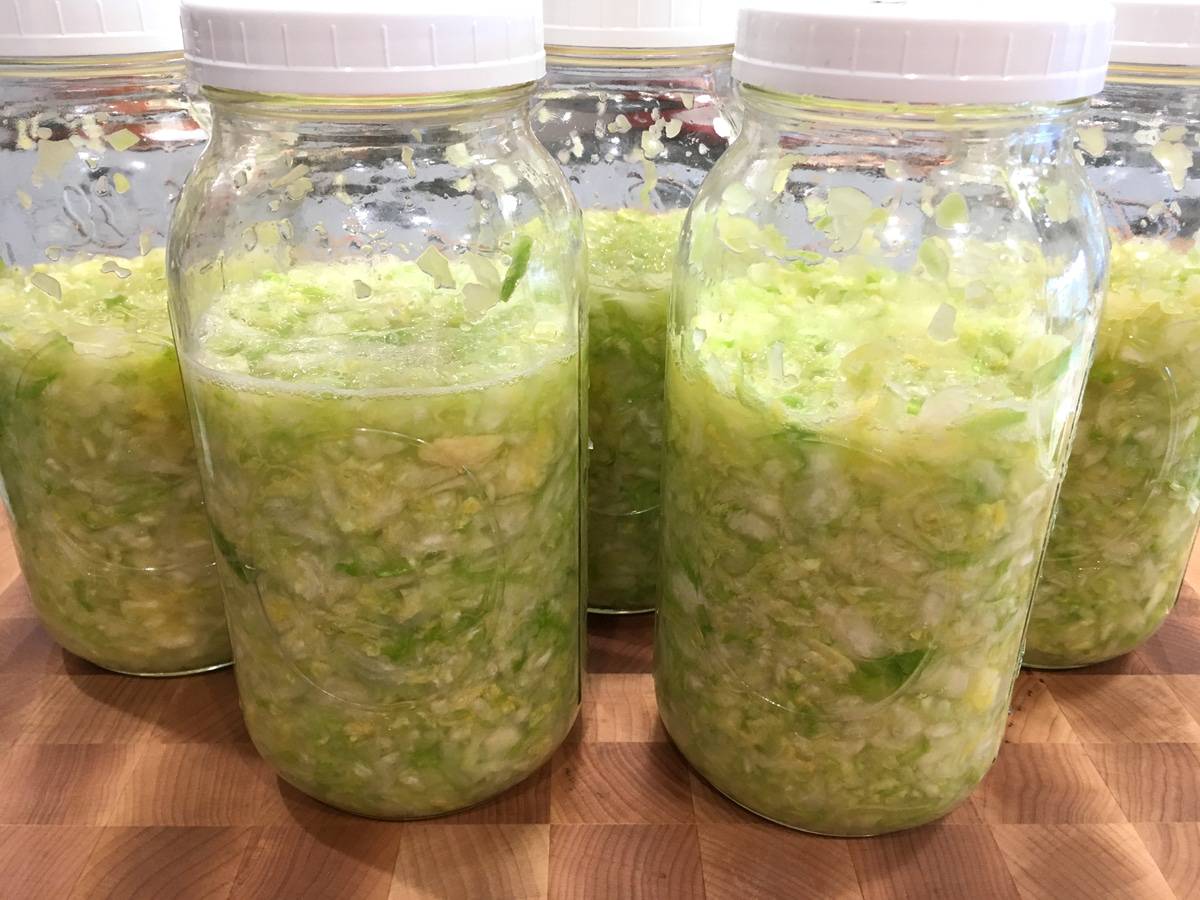
At a the ideal temperature range of 65-70 F we recommend fermenting the cabbage for at least 2 weeks (we recommend longer) but follow your own taste.
After 4 days of fermenting start tasting the cabbage daily until it reaches the desired texture and level of tanginess. Don’t be alarmed if the brine becomes fizzy, this is completely normal and a positive sign of microbial activity.
The color of the cabbage will change from green to a pale yellowish beige (in the pic below compare the green-colored cabbage in the jars, still in the early stages of fermenting, with the finished sauerkraut in the middle).
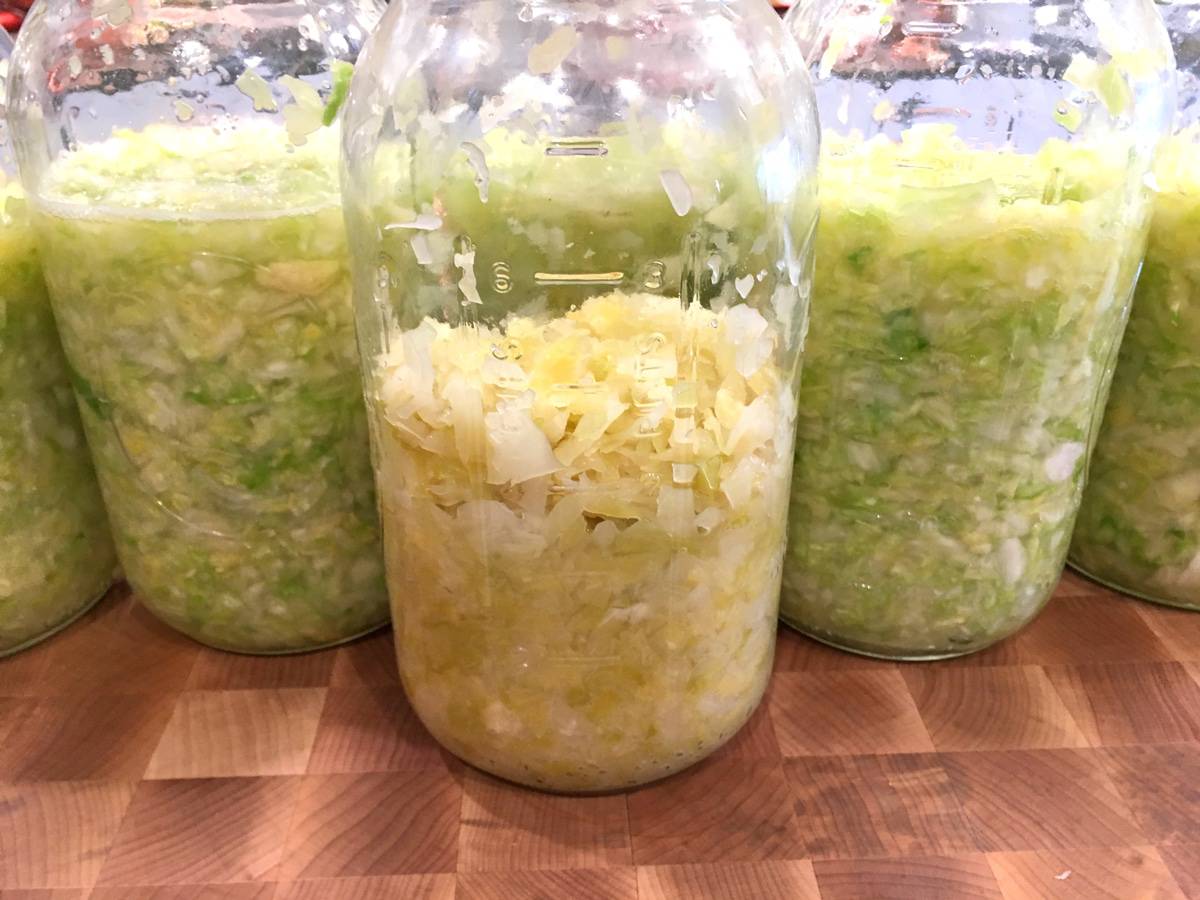
Once your sauerkraut has reached the level of tanginess that you want, it’s time to screw the lid on tight (remove the airlock lid if using and replace it with a regular lid).
Store the sauerkraut in the fridge or a cold cellar. The storage temp should be between 38-50 degrees F. Fermentation won’t stop but it will be greatly slowed down.
Stored in the fridge the sauerkraut will keep for many months. (See section above “Does Sauerkraut Go Bad?”) If your sauerkraut is too salty for your taste simply give it a rinse before eating.
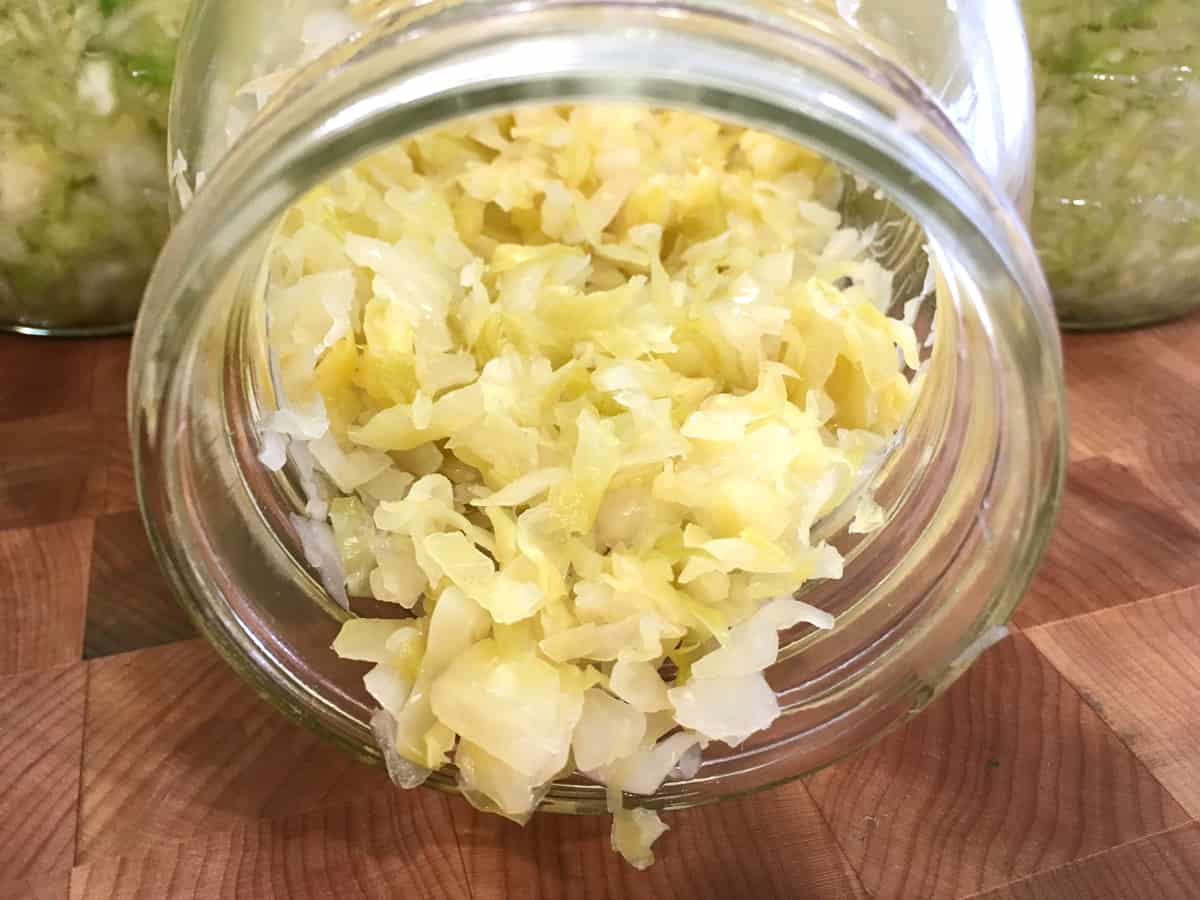
Eat your sauerkraut raw to reap the benefits of the probiotics or use it in any recipe calling for sauerkraut.
Enjoy!
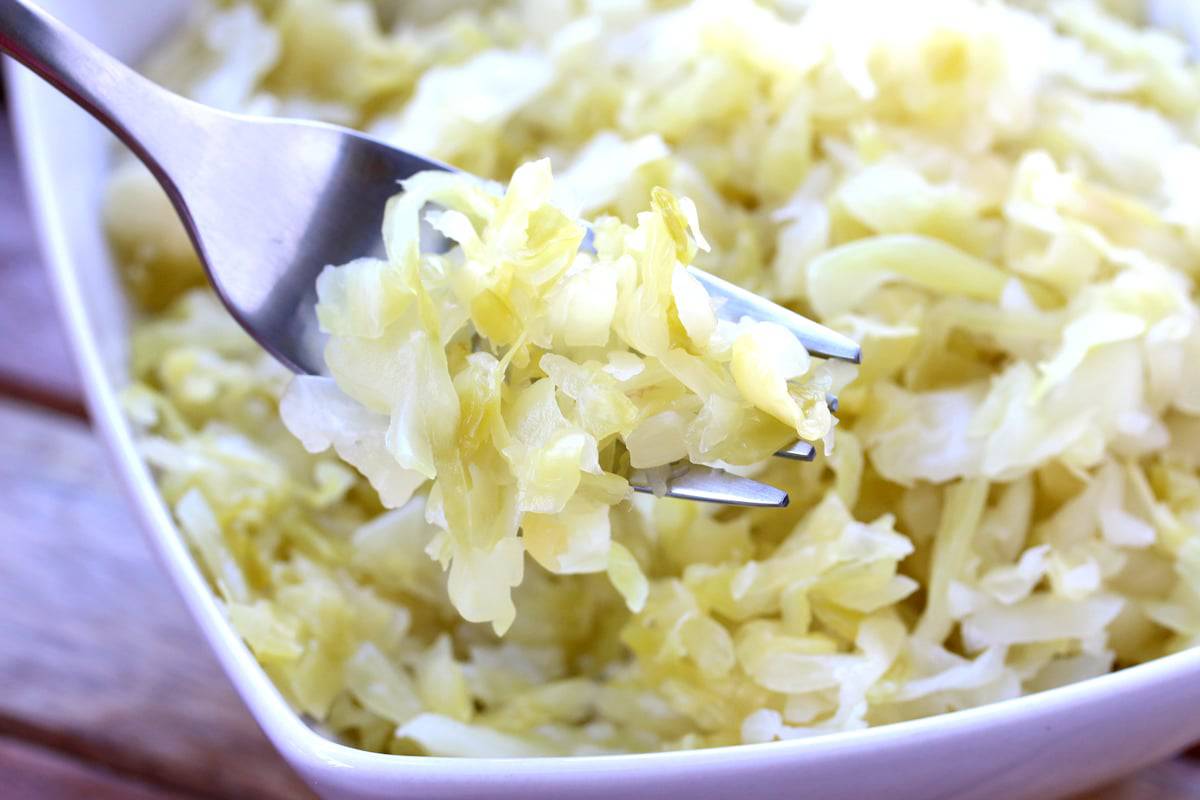
For sauerkraut recipe ideas be sure to try my:
Be sure to check out my tutorials on:
Save This Recipe
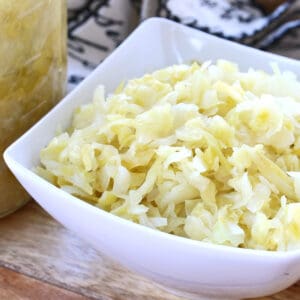
How to Make Sauerkraut
Equipment
- Jars I regularly use these ones!
Ingredients
- 1 1/2-2 teaspoons salt for every pound of cabbage (9-12 grams salt per 450 grams of cabbage) (use sea salt or kosher salt – avoid iodized salt because it can inhibit fermentation and make sure that whatever salt you use contains no anti-caking ingredients)
- very fresh green cabbage (The fresher the cabbage the more juice it will have to make a sufficient amount of brine. The finished sauerkraut will also have a much better texture.)
Instructions
- Prepare the Cabbage:Remove any bruised or damaged exterior leaves from the cabbage, then cut the cabbage in half and remove the core. Slice the cabbage very thinly, approximately 1/8 inch thick. For the best texture we recommend slicing it very thinly by hand, not with a food processor. You can slice it by hand, use a mandolin, or cabbage slicer.Place the sliced cabbage in a large bowl and toss in the salt. Let it sit for about 20 minutes until the cabbage has begun to wilt and releases some of its juices. Use a tamper/pounder to crush the cabbage until it is wilted and has released a lot of liquid. This will takes several minutes.
- Pack the Cabbage in a Crock or Jar:Transfer the cabbage and all the juices to a glass or ceramic jar or crock a bit at a time and mash it down with a tamper. Fill the jar to about 2/3 full (the cabbage will bubble as it ferments and could overflow if the jar is too full).Continue to mash the cabbage with the tamper, releasing more juice, until the cabbage is completely submerged under the brine and any air pockets have been removed (important for preventing mold growth). If you've mashed all you can mash and you still don't have enough brine to cover the cabbage you'll need to make some supplemental liquid that is consistent with the salinity of the cabbage brine: Dissolve 1 teaspoon salt in 1 cup water (a 2% solution of salt water) and add that to the jar until the cabbage is completely submerged under the liquid.It is imperative that the cabbage remain submerged under the brine during fermentation, otherwise mold will form (See blog section "My Sauerkraut Has Mold on it: Is it Safe to Eat?"). To do this choose a heavy object whose diameter is roughly the same size to the inside of the crock you're using. The object should be glass, ceramic, or non-reactive metal.Note: I have made sauerkraut multiples times in large mason jars (usually 1/2 gallon size but you can use smaller jars) without needing to use a weight. Because of the small diameter of the jar, after a day or two of fermenting the cabbage usually remains below the liquid level. If the cabbage rises above it I just mash it back down with the tamper. If you choose to use mason jars without using something to weigh down the cabbage, just be sure to keep a close eye on it each day throughout the fermentation process.Screw on the lids to fingertip tightness (this is important to prevent exploding jars!). If using airlock lids, follow the instructions provided.
- Ferment Your Sauerkraut:Place the jars in a dark place that is between 65-70 degrees F, the ideal temperature for fermenting. (See blog section "How Long Does it Take to Ferment Sauerkraut" for information on temperature variations.)At a the ideal temperature range of 65-70 F we recommend fermenting the cabbage for at least 2 weeks (we recommend longer) but follow your own taste.After 4 days of fermenting start tasting the cabbage daily until it reaches the desired texture and level of tanginess. Don't be alarmed if the brine becomes fizzy, this is completely normal and a positive sign of microbial activity.Note: If you're not using an airlock lid be sure to open the lid of your jar/crock every day to release the pressure and prevent your jar from exploding. The color of the cabbage will change from green to a pale yellowish beige.
- Store Your Sauerkraut: Once your sauerkraut has reached the level of tanginess that you want, it's time to screw the lid on tight (remove the airlock lid if using and replace it with a regular lid).Store the sauerkraut in the fridge or a cold cellar (storage temperature should be between 38-50 degrees F). Fermentation won't stop but it will be greatly slowed down. Stored in the fridge the sauerkraut will keep for many months. (See blog section "Does Sauerkraut Go Bad?") If your sauerkraut is too salty for your taste simply give it a rinse before eating. Eat your sauerkraut raw to reap the benefits of the probiotics or use it in any recipe calling for sauerkraut.
Originally published on The Daring Gourmet January 2, 2021



















Hi
I am loving your recipe and have made wonderful sauerkraut.
just wondering though,
1. If the sauerkraut is way to salty can I add extra liquid to the fermentation process to reduce the saltiness?
2. Can I re use the liquid to make a new batch of sauerkraut when I’ve run out?
Thank you, Cinta, I’m so glad it was a success! To answer your questions: 1) yes, the salt can be reduced either by using less to begin with or by adding some extra liquid to dilute the saltiness. 2) You’ll hear varying opinions about this but yes, you can re-use the brine (which is full of probiotics) to start a new batch. You can reuse all or just a little of it to inoculate the next batch. Remember that probiotics rely on food to keep going, otherwise they die, so just be sure to use the brine within a few days.
Hello and thanks for this recipe. I am wondering, can add red pepper flakes to the cabbage?
Hi Jeff, yes you can!
hi, kimberly, i’d like to add some extras like cayenne or garlic to make it a little like kimchee. any suggestions?
Hi Mike, you can absolutely do that. Quantity purely comes down to how spicy or strong you like it. You could divide the batch in two and add less to one jar and a little more to the other and then make note of which one you prefer for next time.
Hi Kimberly,
Three weeks into the fermentation of my first batch of kraut, and I find it a bit lacking in ‘sauer’ (not as tangy as I would like it to be).
Should I just leave it to continue fermenting (if so, for how long)? Or, is there another way to increase tanginess, such as introducing lemon juice or vinegar into the fermentation process?
Hi Tali, the sourness is directly related to the fermentation time – the longer it ferments the more sour/tangier it will become. So yes, just let it continue to ferment until it tastes the way you want it to.
I don’t get all your photos of the finished fermenting kraut don’t have anything weighing them down and are breaking the number one rule of sticking out of the brine. Is this just for show or do you really leave it like that?
Hi John, those pictures show the finished Sauerkraut ready for eating.
Thank you for this nice easy to follow recipe. I have no glass jars big enough to hold even one pound of cabbage. I hope my using a stainless steel pot will not ruin my sauerkraut, my plate is perfect size for it. Please advise if you think this is not a good idea.
Hi Judy, I’ve never used stainless steel for fermentation before and you’ll find very mixed opinions about it online. I think generally the consensus though is that as long as it’s quality stainless steel it’s fine (cheaper stainless steel can be reactive and pitting can occur). Please let us know how it goes!
Is there a recipe where you put cabbage, salt, vinegar, and a little sugar, top with boiling water, seal and hot bath 20 min? I lost the recipe! thank you
Well said Kimberley, obviously Barb has issues in her life hope she is Okay and apologies 🙏 if not keep on doing what you do best as you can’t control those who are not in their proper state of mind.
☮️
Kimberly, I love your recipes! The sauerkraut recipe is fantastic. You are My-Go-To when I’m looking for a new recipe. Thank you for everything you do.
Oh thank you so much for that generous compliment, Dinah, and I’m thrilled that you enjoyed the sauerkraut! <3
I just wanted a good recipe, not to see all about you Kim. you must be very arrogant. I want nothing to do with your recipes
Barb, the issue of arrogance likes solely in your court to think that anyone “owes” you a FREE recipe and on YOUR terms. How very ugly! And what you’re referring to as “all about me” is literally limited to two short paragraphs at the very beginning. This is my personal website, Barb, an extension of my own home, and if you want sterile recipes without personality, by all means go somewhere else. But to say you want “nothing to do with” my recipes because of a personal intro at the beginning of my blog post is just very sad indeed and I feel sorry for your critical and bitter outlook on life.
Very well said!
Yes girl! Stand up to those trolls who expect the world and give nothing in return other than negativity. Thank you for your recipes and personal intro.
what a deeply disturbed individual you are. You must have a miserable life…
I’m just here to comment on how ridiculous and bitter old Barb is to think that she can dictate your recipe blog. No one cares if you don’t want the recipes bar go cook your flavorless food
Kim
Thank you for your helpful insight in fermenting veggies. Sorry you have been attacked by another Karen. I read your intro and thank you, it is perfectly inline with the subject matter. Barb may have had a bad day, regardless thank you Kim. Barb, get a clue. SMH
There’s a jump to recipe button that’s just a click away if you don’t want to read a blog.
I’m sorry you had such a bad day that you felt the need to post such a nasty comment and I hope your life is filled with love and peace.
What kind of object do you use to weight the cabbage down?
Hi Helen, I have made sauerkraut multiples times in large mason jars (usually 1/2 gallon size) without needing to use anything to weight it down. Because of the small diameter of the jar, after a day or two of fermenting the cabbage usually remains below the liquid level. If the cabbage rises above it I just mash it back down with the tamper. If you choose to use mason jars without using something to weigh down the cabbage, just be sure to keep a close eye on it each day throughout the fermentation process. But depending on the size of the crock that you’re using, you can use something like a small teacup saucer or dessert plate and then place something heavier on top of it.
Thanks for your reply! I am using a smaller mason jar- about 16 oz. As I don’t have anything larger. In fact it’s an old spaghetti sauce jar. The cabbage pieces touch the top of the water- I guess they float. Is that ok, or will mold form?
Hi Helen, you can also fill a small food-safe ziplock bag with just enough water to weight it down and let it sit on the top of the cabbage mixture. Alternatively, just mash the cabbage down at least a couple of times day throughout the fermentation period and that should prevent mold from forming.
Could this possibly be frozen in freezer bags instead of canned after the fermentation process is complete?
Hi Amanda, from a safety standpoint yes, but just know that the freezing temperatures will kill the healthy probiotics (as will canning or cooking the sauerkraut).